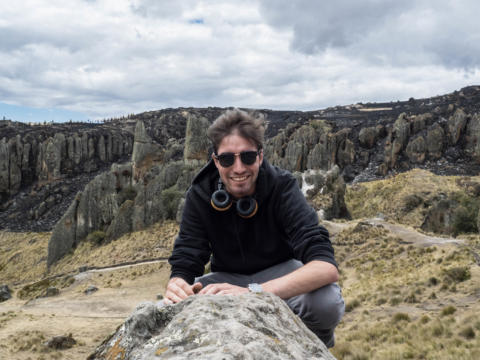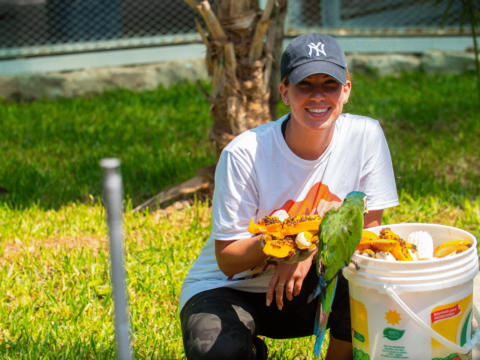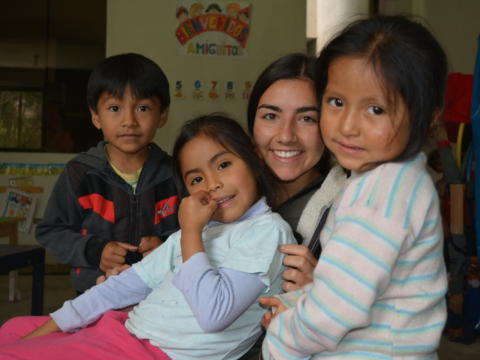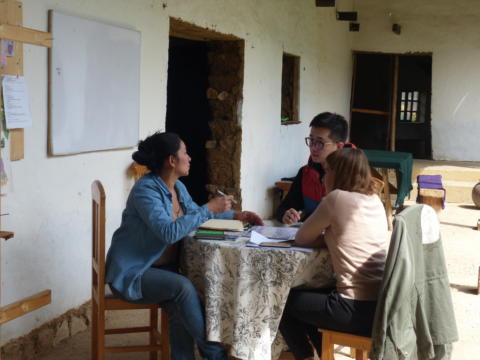Only 600€ per week!
Endangered Animal Sanctuary
Lambayeque (Chiclayo) - Peru
Improve the lives of endangered species native to the coast and jungle of Peru. Support the good works at the centre that supports the Humboldt Penguins!
Take part in activities that will help build and maintain safe habitats for vulnerable animals and stop a further decline in their numbers. Efforts to assist Humboldt Penguins continue, but are challenging. Your ongoing help is needed! The energy you put in, will truly help many endangered animals out!
Program Description
Animal care duties await you!
Try your hand as the assistant warden in a private Peruvian animal sanctuary, – open to all lovers of wildlife, and especially perfect for those who are conservationists or students of nature and zoology.
You will participate in the daily caretaking of all animals and especially in the centre’s efforts to create a safe habitat for all of the animals.
The Humboldt Penguins, which were relocated here were unfortunately devastated by the recent flooding that took place in this area. As a result, all but one of the penguins has died due to illness after this natural disaster. As the centre continues to work to assist the surviving penguin in quarantine and prepare for the possible addition of a new waddle of penguins, your help and support is greatly needed and appreciated.
This centre assists all sorts of rescued animals and helps to halt the decline of endangered species, as well as, spread awareness about the issues they face. Your involvement provides opportunities for these good works to continue. Even though you may not get to work directly with the beloved penguin population, every bit of energy put into making this habitat better for all of the animals supports the ongoing progress of the only centre in the region working to assist Humboldt Penguins.
Animals at this location include, but are not limited to:
-Variable Hawks -Ground turtle -Monkey Friar -Coati -Peccaries -Ostriches -Sheep -Sloths -Kinkajú
-Guacamayos -Manchin Monkey -Agouti Paca (large rodent) -Choro Monkey -Musmuki monkey
-Andean Fox -Howler Monkey -Crocodiles -Guinea pigs -Rabbits -Wild turkeys
Your role will include construction work, reforestation, cleaning, as well as the preparation of food/feeding for the animals at the centre.
Please note that while you might not have the chance to touch all of the animals (as some are very sensitive and get scared easily), the reward of your efforts will be in knowing that you help them to thrive and not just survive!
Aims & Objectives
- Gain practical, hands-on experience in animal conservation
- Assist the program and its staff with your efforts
- Give you the chance to learn about, and bond with the animals that are endangered.
Schedule
Monday
If your first week, after breakfast, you’ll get a training and orientation about your project: what your tasks will be, as well as your Do’s and Dont’s during the week. Then you’ll discover all you need to know about the animal center, together with the coordinator and other participants.
You’ll get plenty of background information about the many fascinating species of animals that are receiving support and attention as you learn about their special needs and behavior. We’d like to make sure you’re prepared the best way possible for your experience, so if you have any questions, don’t hesitate to ask our experienced coordinator!
After the detailed introduction. Depending on number of participants, some daily tasks can take place in the mornings or in the afternoons, in either of these cases, participants will always be able to make plans to visit the local villages surroundings and beaches nearby.
Tuesday to Thursday
On the average day here you’ll start your project and take part in environmental or conservation activities such as:
- Construction work
- Creating a natural fence
- Reforestation of cactus
- Vegetable garden and nursery maintenance
- Preparation of food for the animals
- Feeding animals
- Preparing material to teach general public and children about the animals.
Expect about 6 hours of activities per day!
Friday
After breakfast you will go to a nearby school to forward the information you’ve gained and developed during this exciting week to the students. In this way, you help promote the conservation of the animals at the centre and raise awareness of environmental issues affecting the wildlife in Peru. Afterwards, you will have free time to relax or explore the area.
Note: This schedule can be changed and/or amended depending on weather conditions, local conditions and unforeseen circumstances.
Participant Criteria & Requirements
Standard Requirements
Minimum age: 18
Maximum age: –
Minimum English level: Basic
CRB required: On Signup
Passport copy required: On Arrival
Resume copy required: No
Required qualification: None
Additional Requirements
There are no further requirements for this program.
Additional Equipment
No specific equipment required for this program.
Location
This accommodation is not too far away from the north beach side of Peru, just 45 km from Chiclayo, the fourth biggest city of Peru, which offers shopping centers, a cinema and nightlife, it is also a traffic hub in north Peru.
Closer by, many other highly important historical and archaeological sites, as well as small villages, restaurants or shops are easy to access by cheap and frequent public transport, making it easy if on weekends or after your program you wish to travel the surroundings.
About the Accommodation
Jayanca, Lambayeque is considered to have a desert climate. During the year, there is almost no rainfall. This is unlike our other locations in Peru so you should pack your clothes accordingly.
Your accommodation is actually an Ecological Tourist Center that offers to its clients a variety of facilities and recreative activities and supports a private zoo!
Our developed program with this center offers a great opportunity for participants to learn and practice real administrative and ecological skills while enjoying the culture and surroundings.
Rooms will be cleaned by staff regularly but you will be expected to clean up after yourself, and to play your part to keep the accommodation neat and organized. There is Wi-fi in your rooms as well as public areas here for your convenience.
Food Arrangements
The food will be based on the staff daily menu, which is typically Peruvian, meaning lots of sweet potatoes, beans, rice, chili peppers, potatoes, wheat, and other grains, all very vegetarian friendly. Keep in mind that some local dishes may be spicy!
Facilities
Since our center is a tourist center itself, there are options (under very strict restrictions) for the usage of slides, swimming pool area, boats, green areas, sport areas/fields, four-wheelers, zoo access and grill areas. In the nearby surroundings you will have access to a range of facilities
Shops
There are many local shops and restaurants within walking distance of our centre.
Transportation
The accommodation is about 1 km walking distance from the main square of Jayanca town, and about 1hr away from the Chiclayo city center by bus.
Money
There are numerous shops and ATMs in the central town.
Activities & Events
No scheduled activities outside the program.
Sights & Surroundings
In and around our location and besides the mainstream tourist routes, there is an array of places and sights that our participants can visit on weekends or free time. Even if you stay in this site for a few months, you won’t run out of astonishing places to visit!
Lambayeque District
Walking distance from our location by 30min you’ll reach a variety of attractions including:
Lambayeque Town
The Headquarters of The Moche Culture, where you can find the great Museo de Chonacab Lambayeque.
The Mochumi route
Known for its rich agricultural variety.
Illimo
Capital of our honey bees.
Pacora
Land of the chicha de jora.
Jayanca,
Town of the wine and sun.
Cruz de Motupe
Just 20 min away you will find this holy site of a large cross sitting on a hill, which can be accessed by a man-made pathway. Many make pilgrimage here to pray and this cross is brought down into town for a festival in early August and carried to a local church. There is a lot of historical and cultural significance surrounding the Cruz de Motupe for the people of Lambayeque and greater Peru.
Tumbas Reales – Senor de Sipan: Best Museum in Latin America
In Ferrenafe town, just 40 min away. The museum in Lambayeque, just a bit more than an hour from our center, is considered the best museum in Latin America because it exhibits one of the most important gold treasure discoveries in ancient Peru and the world. You’ll view amazing artifacts of gold, silver, precious stones and other metals. You should take a guide to fully understand all the exhibits. Go in a group and you can split the cost of the guide.
Tucume
15 min distance, The “valley of the pyramids”, discovered just a few years ago, once formed the world’s largest pyramid complex. Restauration started a few years ago and a new and extensive museum just opened it’s doors.
Bosque de Pomac
10 min: Visit the world’s largest dry forest just north of Chiclayo. Besides Peru’s oldest tree it also hides pyramids of the Sican culture. The attentive visitor can easily spot left overs of antique ceramics or even bones along the walkways. Combine the visit with a horseback ride to get the most out of it.
Chiclayo
40 min. Where you can find the Mercado Modelo: Famous witch doctor’s market is a huge market in the center of Chiclayo not only offers tons of fresh fruits and vegetables, meat, fish and other kinds of food you might not have seen before as well as services like tailors and shoemakers, but it also hosts the famous witch doctor’s market. There you find shark jaws, deer legs, snakeskins, potions, scent and amulets. There are heaps of dried mountain herbs and San Pedro cacti, which shamans use to produce a hallucinogenic drink.
Huaca Rajada
Some of the world’s most extraordinary tombs, place of discovery of the “Lord of Sipan”, also known as the "King Tutankamon of the Americas". Most of the treasures found the tombs are now displayed in the museum Tumbas Reales, but still the site is definitely worth a visit.
Huaca del Sol & Huaca de la Luna
Well known pyramids of the Moche culture, hosting Peru’s best preserved murals. One used to be an administrative center, the other one a religious complex.
While you can visit the pyramids in a single day, getting back to Chiclayo by night, we recommend combining the visit with a tour through Chan Chan, staying overnight at the popular beach of Huanchaco. Take the chance to also visit beautiful colonial Trujillo.
Chan Chan: World’s largest adobe city
Chan Chan not only used to be America’s biggest city, but also was and still is the world’s largest city built of adobe – sun dried mud-bricks – with walls as high as 12 meters, being home for about 60.000 inhabitants. Since it was conquered by the Inkas, it’s extension declined to about 20 square kilometers, of which only a few parts are actively restaurated. As this impressive place is endangered by the more and more frequently occurring El Niño storms, consider visiting it soon.
Transportation
From this location we provide free transport to your next program at the following location(s):
- Cajamarca
- Huanchaco
- Chiclayo
Quick Facts
Name: Republic of Peru
Population: 31 million
Capital: Lima
Language: Spanish (Quechua, Aymara)
Currency: Nuevo Sol (PEN)
Time zone: PET (UTC -5)
Country Information
Peru is the third largest country in South America; a country known for its incredible cultural heritage such as the renowned Machu Picchu and the remains of the Inca Empire. Although the Incas are the most famous ones, there are other manifestations of pre-Columbian cultures and unexplored archaeological sites which can be located in the North of Peru. This magnificent land composed of a variety of landscapes, climates and biodiversity, is visited by tourists from all over the world.
In Peru, it is possible to enjoy a range of activities from surfing in the Northern beaches to hiking in the Andes Cordillera, from trekking in the humid and hot Amazon rainforest to visiting cultural sites, excellent museums, and enjoying traditional dishes. Peruvian people are very friendly, warm, and ready to help or to introduce you to their customs. You will find in these regions a great diversity of ethnic groups, festivities, handcraft, and gastronomy.
Peru is a country of contrasts where the crazy traffic is surpassed by the majesty of mountain ranges. You will find cities peaking at altitudes of more than 6700 meters, infinite beaches with beautiful sunsets, the magically diverse landscape of the tropical rainforest and let’s not forget about the llamas.
Climate
Despite being near the Equator, the presence of different regions of the Andes Cordillera and the arid coast along with the effects of the cold Humboldt Stream induce highly distinct weather. The climate in Peru consists in three main regions: Costa, Sierra, Selva (the coast, the mountains and the jungle).
Costa
The coast of Peru represents 10% of the whole surface of the country. Within this part of the coast, the north has a semi-tropical climate. Because of the Humboldt Stream, the temperatures are not that hot for a desert. The temperature is around 24°C all year long. The Southern region, including the central coast and the south, has a subtropical climate. The temperatures range from 15°C during the winter to 26°C during the summer. Summer is from December to March.
Sierra
Alongside the Andes Cordillera, the winter is dry and the summer rainy. The annual temperatures fluctuate from 11 to 16°C but with wide differences from one site to another because of the different altitudes. Therefore, it is better to come during the winter from May to September during the dry season and enjoy the Costa during the summer.
Selva
This is the Amazon region of Peru that represents 60% of the Peruvian surface. The climate is humid, hot, with rainfall all year long and especially during the rainy season from January to April. During the dry season, it usually rains once per week with temperatures fluctuating around 30°C.
In any case, it is preferable to have 3 kinds of outfits for cold, hot and rainy weather. This beautiful country has different climate zones since it has deserts, mountains and Amazon rainforest.
Culture
The Peruvian culture is widely known for its Inca Empire and the ruins of Machu Picchu. However, Peru includes a lot of other different cultures that are lesser known. Before being colonized in the 16th century by Spain, and before the Inca Empire, other cultures were already very organized, structured economically and politically. This is particularly the case of the Chavín and Mochica cultures which date from 1800-200 BC. Hidden archaeological treasures of these cultures are present in the north of Peru. The Lambayeque Region is the biggest hotspot of unexplored archaeological places in the world while the south of Peru is the most touristic region with Cusco, Machu Picchu and Arequipa.
The country recognizes the practice of other religions. Nevertheless, since its independence from Spain in 1821, Peru remains mainly catholic at 80%. Therefore a lot of churches are present in the country. Inspired from the colonial style, they often constitute the sights to see, along with buildings from the same era in big cities such as Chiclayo, Piura, Trujillo, Arequipa, and Lima. Even with Catholicism as the predominant religion, several events and festivities in Peru refer directly to Inca celebrations and ceremonies. Peru is a colourful country, as evidenced by the traditional fabric you can find in the handcraft markets.
The city of Cajamarca is renowned for its carnival where paint battles take place every year. If you are out and about on those days, expect to be targeted with paint and water during the celebration. Peru is also a country of dances. The national dance is the Marinera and it is frequently practiced along the coast, while traditional tribal dances can be found in jungle areas.
Nowadays, Peru is a multicultural country due in part to the colonialism period, but also because of the different migration phases. The indigenous population represents 45% of the population while the rest is a mixture of different ascendances. A third of the population is Metis and has Spanish origins. Then there is a melting pot of European, African and also Asiatic people. The indigenous are more present in the Selva while the rest of the country is mixed with the other ethnicities. Also, in the jungle and mountains, it is more frequent to see people wearing traditional clothes such as the poncho, the hat and the long skirt for women. While the Amazon represents 60% of the Peruvian surface, it is the least densely populated region of the country. Therefore, it holds lots of beautiful unseen areas and uninhabited parts, which remain untouched by humans.
Gastronomy
Another important sector in Peru is the fruit production. Peru is a land of fruit trees, like Mango and Cherimoya, which are very tasty.
Peruvian gastronomy is award winning! Among its specialities are the Ceviche, which is made with raw fish, seasoned with lemon and spices, the Anticuchos made with beef heart, the Chicha Morada, a national drink made with purple corn, and the national alcohol: Pisco.
Peruvian gastronomy is considered to be one of the most diversified and famous in South America. Very often, dishes include rice; this may be in part because of the Chinese migration influence. Since then, “Chifa” in Peru has been used in reference to Chinese cooking.
Transportation
Public transportation in Peru is very easy and the travel costs are low. The traffic may be crazy in Lima and in general, but for long distances, the most common means of transportation is by bus and it is very safe.
Perú shares borders with Brazil, Colombia, Chile, Bolivia and Ecuador. This is great for travelers because it is very easy to combine different destinations. One such option is Peru and Ecuador, which has one of the most biodiverse landscapes in the world.





